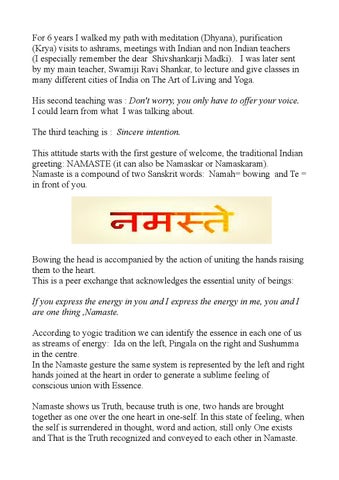For 6 years I walked my path with meditation (Dhyana), purification (Krya) visits to ashrams, meetings with Indian and non Indian teachers (I especially remember the dear Shivshankarji Madki). I was later sent by my main teacher, Swamiji Ravi Shankar, to lecture and give classes in many different cities of India on The Art of Living and Yoga. His second teaching was : Don't worry, you only have to offer your voice. I could learn from what I was talking about. The third teaching is : Sincere intention. This attitude starts with the first gesture of welcome, the traditional Indian greeting: NAMASTE (it can also be Namaskar or Namaskaram). Namaste is a compound of two Sanskrit words: Namah= bowing and Te = in front of you.
Bowing the head is accompanied by the action of uniting the hands raising them to the heart. This is a peer exchange that acknowledges the essential unity of beings: If you express the energy in you and I express the energy in me, you and I are one thing ,Namaste. According to yogic tradition we can identify the essence in each one of us as streams of energy: Ida on the left, Pingala on the right and Sushumma in the centre. In the Namaste gesture the same system is represented by the left and right hands joined at the heart in order to generate a sublime feeling of conscious union with Essence. Namaste shows us Truth, because truth is one, two hands are brought together as one over the one heart in one-self. In this state of feeling, when the self is surrendered in thought, word and action, still only One exists and That is the Truth recognized and conveyed to each other in Namaste.
